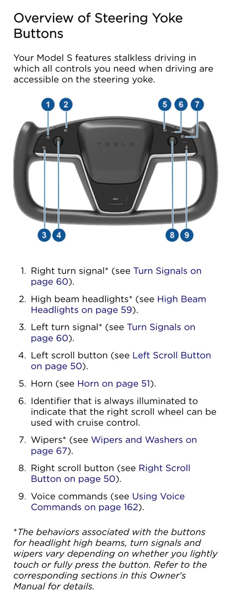Apple’s laptops from 2016-2020 suffer from an unfortunate design flaw: Over time various keys stop working properly. For a company rightly known for superior hardware design and function these laptops remain, for this reason only, one of the darkest blemishes on their proud history. These laptops are fundamentally broken from a hardware design perspective and no amount of software updates will fix that. If a key on a keyboard doesn’t work, well, it doesn’t work. It took Apple 4-5 years to correct this problem by going back to their original hardware keyboard design.
I mention this because software flaws frequently can and are fixed by updates. You can screw it up mightily on the software end of things, ship a downloadable revision, and all can be right again. Software is a relatively affordable fix as a result. For hardware, the fixes are very expensive assuming they can be fixed at all.
Tesla is about to embark on their own voyage of discovery. I was skeptical of Tesla’s new yoke steering wheel for the Plaid Model S and Model X. I have now seen video, so I feel comfortable joining the chorus of Tesla enthusiasts who are aghast at the steaming pile that is the yoke steering wheel. It offers the singular advantage of an unobstructed view of the driver dashboard. It is horrible in all other respects, vastly inferior to the traditional circular steering wheel it replaces. Like many others (again, Tesla fanboys not critics), I would never purchase a car with a yoke steering wheel. It is dangerously bad.

It does not help that Tesla has removed the turn signal stalk and replaced it with capacitive buttons on the steering wheel. Not only do the buttons contradict years of muscle memory from driving other cars, the buttons themselves are ridiculously hard to hit. For locations with roundabouts, turning the yoke steering wheel while attempting to signal your exit from the roundabout is just about impossible.
The gear shifter for the new Teslas has been eliminated. The car will now automatically attempt to ascertain your preference, presumably mostly drive, reverse, or park, and automatically initiate that. It can be overridden on the touchscreen should the car get it wrong. It remains to be seen how well this functions in the day-to-day. I’m most optimistic about this feature, but consumers are being ask for a lot of faith. In many circumstances car absolutely cannot get this wrong without potentially dangerous consequences.
I generally applaud efforts to reimagine the automobile. We’re hauling around a lot of legacy tech in our cars and Tesla’s done a great job, particularly in the Model 3 and Model Y, of improving that experience. With over-the-air software updates, the Model 3 I bought in 2018 is a substantially better car today than what I started with.
But yoke steering wheels, lack of a turn signal stalk, and the disappearance of a physical gear shifter can’t be fixed by software. I think Tesla is about to learn a painful lesson about the need to get hardware right.